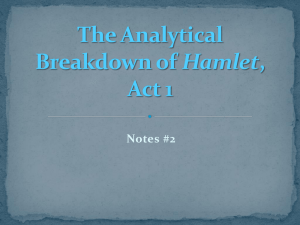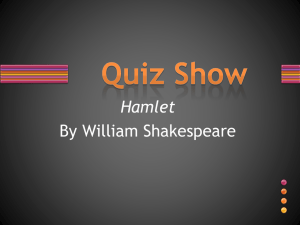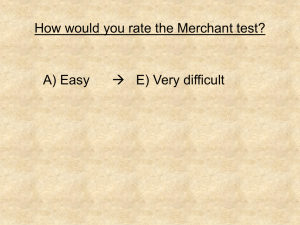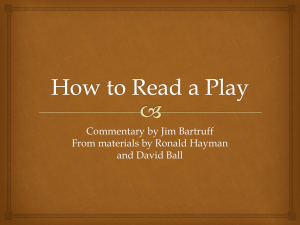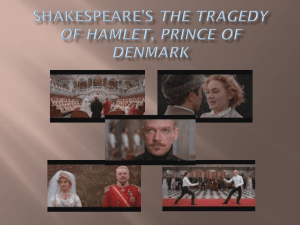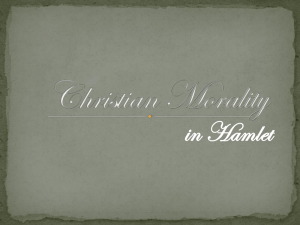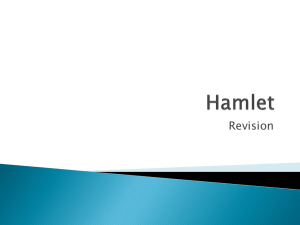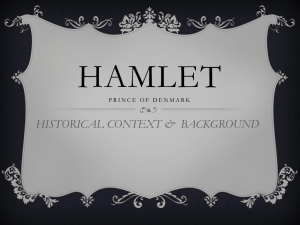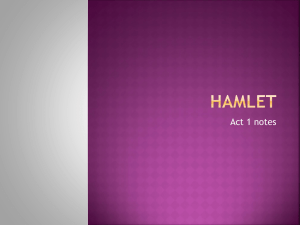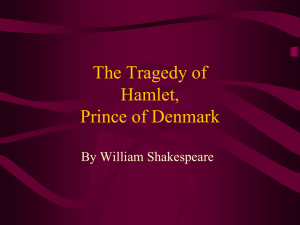Literary Terms and Devices
advertisement
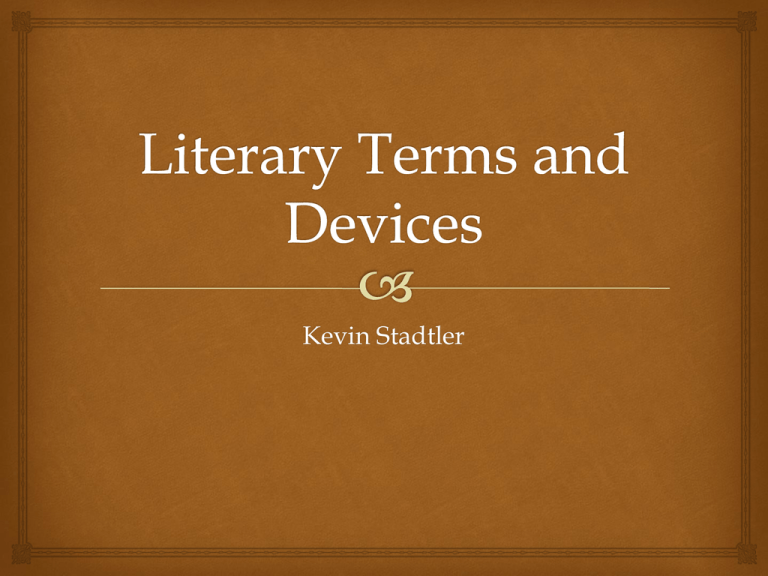
Kevin Stadtler Figurative Language Figurative language is a word or phrase from everyday literal language for the sake of comparison, emphasis, or clarity Imagery Imagery is the usage of words which cause people to imagine pictures in their mind of a scene or situation In act 1 scene 5 lines 60-65, the Ghost uses imagery when he says “That swift as quicksilver it courses through The natural gates and alleys of the body, And with a sudden vigor doth posset And curd, like eager droppings into milk, The thin and wholesome blood: so did it mine; And a most instant tetter bark'd about,” In Bob Dylan’s song, Mr. Tambourine Man, he uses imagery when he describes where he finds peace, “Then take me disappearin' through the smoke rings of my mind Down the foggy ruins of time, far past the frozen leaves.” http://vimeo.com/64904508 Simile A simile is a comparison between objects using like or as to make a description more vivid. In Act 1 scene 5 lines 24-25, the ghost exclaimed “Thy knotted and combined locks to part And each particular hair to stand on end, Like quills upon the fretful porpentine.” In the song, Lover of the Light by Mumford and Sons, a simile is used when they sing “With skin too tight and eyes like marbles.” http://www.youtube.com/watch?v=nMJUbZrNnA8 Metaphor A metaphor is a comparison or assertion of likeness between two seemingly unlike objects. A metaphor does not use like or as. Hamlet says after meeting the ghosts that he will “Yea, from the table of my memory I'll wipe away all trivial fond records, All saws of books, all forms, all pressures past, That youth and observation copied there”(I. 5. 98101). Hamlet here is basically comparing his head to a slate that is full of information and he can wipe it all off with one quick sweep. Mother Teresa uses her life as a metaphor when she says “I'm a little pencil in the hand of a writing God, who is sending a love letter to the world.” Personification Personification is when an inanimate or nonhuman object is given the characteristics of a human being. Claudius says in act 5, "And let the kettle to the trumpet speak" (V.2.277). Here he is saying that he will drink wine if Hamlet wins the fencing match with Laertes. Ryan Bingham, in his song Hard Times, says “Hard times, Creepin up on the good folks you know.” Here the Hard times are given a human persona of creeping up or being sneaky. http://www.youtube.com/watch?v=5o181GOT8Vg Apostrophe An apostrophe is when a speaker or writer breaks off from addressing the audience and speaks to an opponent or to a third party not involved in the conversation. Hamlet says “O God! God!” as an apostrophe in Act 1 after Claudius and Gertrude beg him to stay in Denmark and not return to school. (I.2.132- B) In the rap, Mercy by Kanye West with Big Sean, Pusha T, and 2 Chainz, there is an apostrophe when a voice comes on saying “It is a weeping, and a moaning, and a gnashing of teeth It is a weeping, and a moaning, and a gnashing of teeth It is - when it comes to my sound which is the champion sound Believe! Believe!” This voice speaks http://www.youtube.com/watch?v=WGX5-3G_1v4 Symbol A symbol is something that represents or stands for something else, while still remaining in its current disposition. In Act V scene 1, Hamlet ponders upon death with the skull which he held in his hand. The Skull symbolizes that we are all dust and our time is winding down. Here he says “he hath borne me on his back a thousand times; and now, how abhorred in my imagination it is!” (V.i.171-172). The stars on our national flag are symbols or representations for all of the separate states united under one flag. Allegory An allegory is a story or a poem that can be interpreted to have a deeper meaning about morals or life. An example of an Allegory is in Act 3 scene 2 when Hamlet has the Players portrait the murder of Hamlet Sr. by Claudius. This had a deeper meaning to both Hamlet, Claudius, and Gertrude , who was also involved in the story the players preformed. Books such as Animal Farm and 1984 have been written as allegories to current or possible future event that were to transpire. They contained a deeper meaning then a group of pigs who take over a farm or a man who reads a book. Paradox A paradox is a statement that is contradictory because it contains two statements that are both generally true cannot both be true at the same time. "You are the queen, your husband's brother's wife“(III.4.15). Hamlet says the paradox of the situation that surrounds his mother. The Nirvana song, Come As You Are, is a song which involves paradoxes with lyrics like “As a friend, As an old enemy, Take your time, Hurry up, The choice is yours, Don't be late.” http://www.youtube.com/watch?v=vabnZ9-ex7o Hyperbole A hyperbole is a great exaggeration of the truth or properties of an object. Laertes says, when Ophelia is buried, "Now pile your dust upon the quick and dead, Till of this flat a mountain you have made, To overtop old Pelion”(V.1.258-260). In Bruno Mars’ song, Grenade, he uses an uses an hyperbole when he sings “I’d catch a grenade for ya.” I seriously doubt he would actually do that… Understatement An understatement is when somebody makes out an occurrence or object to be less than what it really was. It is the opposite of a hyperbole. Claudius uses understatement when he describes the situation with young Fortinbras of Norway. He makes it out to be not a big deal at all; but in fact, Fortinbras is ready to attack the castle at any moment. Understatements are commonly used by some parents in dangerous situation towards young children in an attempt to shield them from some of the cruelties of society. Irony An Irony is a situation that is strange or funny because it turns out in a way that you wouldn’t expect it to or want it to. When Hamlet is with his mom, he killed an intruder, who he believes to be Claudius. “Ay, lady, 'twas my word. Lifts up the array and discovers POLONIUS Thou wretched, rash, intruding fool, farewell!” (III.3.30-31). The song, Ironic by Alanis Morissette, sings extensively about irony. With lines like “It's like rain on your wedding day, It's a free ride when you've already paid, It's the good advice that you just didn't take”, she sings about the simple ironies of everyday life. Chiasmus Chiasmus is when terms are used in one order and then subsequently repeated in another order repeated in reverse order Claudius and Gertrude say a chiasmus, feeding off of each other. Claudius leads by saying “Thanks, Rosencrantz and gentle Guildenstern.” Followed by Gertrude saying, “Thanks, Guildenstern and gentle Rosencrantz.”(II.2.34-33). John F. Kennedy used this tool in one of his most famous lines of all time, "And so, my fellow Americans, ask not what your country can do for you; ask what you can do for your country." Metonymy Metonymy is when a person is referred to by the name of the greater entity he or she represents. Claudius refers to the King of Norway, Fortinbras’ uncle, as Norway when he says “For bearers of this greeting to old Norway” (I.2.35). Whenever people today refer to the President, the Whitehouse is often used as a metonymy. Synecdoche A synecdoche is when a part is made to represent the whole or the whole can represent a part. The Ghost refers to the monarchy by as a whole by only using the royal beds they sleep on, when he says "Let not the royal bed of Denmark be A couch for luxury and damned incest.“(I.5.89-90). People often refer to a car as a set of wheels, today. People also can refer to a group of cattle as a head. Repartee A repartee is a conversation which occurs with the initial exchange of witty remarks. In Act II, scene2, lines 371-405, Hamlet take part in a Repartee, which he rules the entire time. Claudius can not ever openly respond to his witty remarks of crazed and improper courtesy because of his much inferior status compared to Hamlet. An example or repartee in todays world is a rap battle between rappers. Here they give each other witty and amusing insults until one side falters. Stichomythia Stichomythia is an exchange of dramatic words between people in which a single line of meter is used. A perfect example of stichomythia is Claudius’ and Gertrude’s exchange with Laertes shortly after he and peasants storm the castle. “L. Where is my father? C. Dead. G. But not by him.” (IV.5.126-128) Many soap operas use stichomythia to convey the drama transpiring in the scenes they are in. Stock Characters A stock character is a person who is quickly entered into a scene and easily recognized as a common individual. An example of a stock character is Osric. He enters into the story as a one dimensional man. He serves no real purpose in the story other than as a comic relief point before the epic battle. A stock character is commonly used in comedy television shows such as South Park, Family Guy, and many more. Musical Devices Alliteration Alliteration is the use of words with the same starting letter and close proximity to each other. The ghost uses alliteration while revelating to Hamlet “With witchcraft of his wit, with traitorous gifts, O wicked wit and gifts, that have the power “ (I.5.43-44) An example of alliteration today is The Beach Boy’s song, Little Saint Nick. They alliterate in the song when they sing “Run run reindeer Run run reindeer” Assonance Assonance is the repetition of the sound of a vowel in stressed syllables, which are not rhyming, close enough to be recognized together. Along with being Alliteration, “With witchcraft of his wit, with traitorous gifts, O wicked wit and gifts, that have the power “ (I.5.43-44) is also assonance because it repeats the “i” Diddy’s song coming home use assonance with the “o” and “ai” when they sing “I'm coming home I'm coming home tell the World I'm coming home Let the rain wash away all the pain of yesterday.” Consonance Consonance is the repetition of the same consonant in near consecutive uses. Consonance is used by hamlet when he says “Thou wretched, rash, intruding fool, farewell.” (III.4.38). The “r” is the consonant that is focused upon. In Eminem’s song, The Real Slim Shady, he uses assonance with the “s” sound. He says, "Will the real Slim Shady please stand up I repeat, will the real Slim Shady please stand up.” Rhyme A rhyme is when two or more words sound the same when spoken in a repeating manner. Shakespeare ends scene 2 in Act I with a concluding couplet which rhymes. Hamlet says “Till then sit still, my soul: foul deeds will rise, Though all the earth o'erwhelm them, to men's eyes.”(I.2.259) Bob Dylan sings with rhymes in his song, Shelter from the Storm. He sings “Suddenly I turned around and she was standin’ there With silver bracelets on her wrists and flowers in her hair She walked up to me so gracefully and took my crown of thorns ‘Come in,’ she said, ‘I’ll give you shelter from the storm’” Rhythm Rhythm is the pace at which a poem or other writing goes at throughout a section of it. The rhythm of Hamlet is a series of stressed and unstressed sounds like a heartbeat. For example, “To be, or not to be: that is the question:” (III.1.56). Rhythm is one of the keystones of Rap music. It is the rhythm that keeps the flow of word on track. It is the rhythm that can determine the direction that a rap goes. Meter Meter is the pace or rhythm of poetry determined by the number and length of feet in a line. In Hamlet, Shakespeare uses a meter of 5 feet in his work. “To be, or not to be: that is the question:” (III.1.56). A decrepit old gas man named Peter While hunting around for the meter His torch he did light He arose out of sight And, of course, as a result, he totally, completely and utterly destroyed the meter! End-stopped line An end-stop occurs when a line of poetry ends with a period or definite punctuation mark. “Nay, answer me: stand, and unfold yourself.”(I.1.2) The end-stop line here is the period at the end of this line. End-stop lines are used today in songs to signify where the artist takes a breath or pause for the instruments to play. Run-on line A run-on line is a line that does not include a punctuation mark, designating the end of a line; but rather continues on. An example of a Run-on line is “And will not let belief take hold of him Touching this dreaded sight, twice seen of us:”(I.1.24-25) A run-on line is common in music because it’s a place where the singer continues to sing without the need to take a breath. Caesura A caesura is a pause that occurs in the middle of a line of verse in poetry. Here, a caesura is used when Francisco says “I think I hear them. Stand, ho! Who's there?”(I.1.13) Caesuras are used today in comedy to give a pause for effect on the audience. Free verse Free verse is a poetic style that lacks a regular, systematic meter or rhyme scheme throughout the writing. Shakespeare chooses not to use free verse in Hamlet. Many poets today utilize free verse in their poems. Walt Whitman uses free verse in his poem, After the Sea-Ship. He said “After the Sea-Ship—after the whistling winds; After the white-gray sails, taut to their spars and ropes, Below, a myriad, myriad waves, hastening, lifting up their necks, Tending in ceaseless flow toward the track of the ship:” Iambic pentameter Iambic Pentameter is a series of 5 iambs in a line of poetry. Of which, an Iamb contains a high and a low beat. Shakespeare uses this meter all throughout his Hamlet. He uses it in his most famous line in the poem, “To be, or not to be: that is the question:” (III.1.56). John Wesley Harding by Bob Dylan is a song written in perfect Iambic Pentameter. He sings “John Wesley Harding Was a friend to the poor He traveled with a gun In every hand.” Grammatical Pauses A grammatical pause is a pause introduced into the reading of a line by a mark of punctuation. Grammatical pause occurred here in the middle of the line as both a period and an exclamation mark. “I think I hear them. Stand, ho! Who's there?”(I.1.13) In Bob Dylan’s song, A Hard Rain's A-Gonna Fall, he uses a grammatical pause in the middle of a line to introduce a new idea. Dylan sings, “Where hunger is ugly, where souls are forgotten.” Concluding Couplet A concluding couplet is the final two lines, which rhyme, at the end of a speech or poem. “More relative than this: the play 's the thing Wherein I'll catch the conscience of the king.” (II.2.591-592) Bob Dylan uses a concluding couplet in his song, Forever Young. He ends it by saying, “And may your song always be sung May you stay forever young.”
